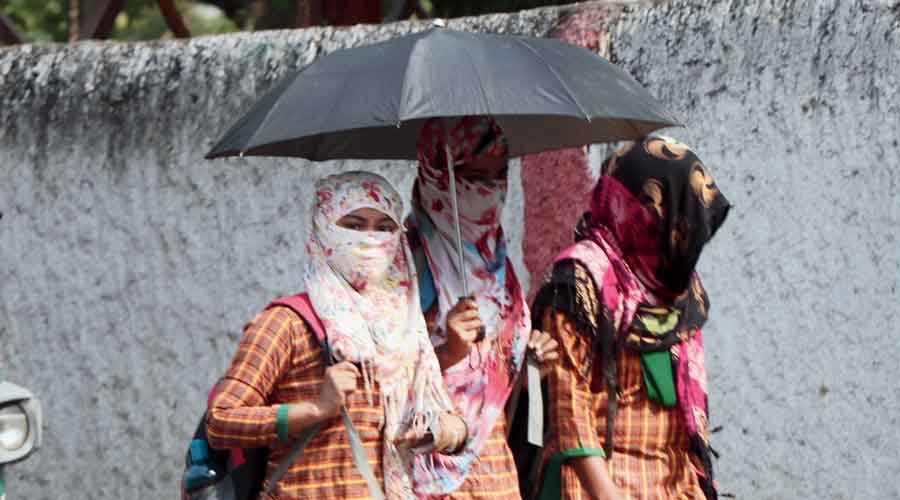A torrid heatwave send temperatures soaring across large swathes of the country on Friday, with Banda in east Uttar Pradesh logging a record high of 47.4 degrees Celsius.
The mercury breached the 46-degree Celsius mark in several places such as Allahabad (46.8 degrees Celsius) and Jhansi (46.2 degrees Celsius) in Uttar Pradesh; Sports Complex (46.4 degrees Celsius) in Delhi; Ganganagar (46.4 degrees Celsius) in Rajasthan; Nowgong (46.2 degrees Celsius) in Madhya Pradesh; and Maharashtra's Chandrapur (46.4 degrees Celsius).
Gurugram recorded an all-time high of 45.9 degrees Celsius. Delhi's Safdarjung Observatory, the national capital's base station, recorded a maximum temperature of 43.5 degrees Celsius for the second day on the trot. It is the highest maximum temperature for a day in April in 12 years in the city. Delhi had recorded a maximum temperature of 43.7 degrees Celsius on April 18, 2010.
Amid the intense heatwave, India's peak power demand reached an all-time high of 204.65 GW on Thursday.
The India Meteorological Department (IMD) said the heatwave spell will persist over northwest and central India till May 2 and over east India till April 30. An 'orange alert' has been issued for Haryana, Punjab, Delhi, Uttar Pradesh, Rajasthan, Madhya Pradesh, Jharkhand, and the Vidarbha region of Maharashtra for Saturday.
The IMD uses four colour codes for weather warnings. Green means no action is needed, yellow refers to watch and stay updated, orange means be prepared and red alert means take action.
The heatwave is expected to abate from Monday under the influence of a western disturbance, which is likely to affect northwest India from the night of May 1, it said.
Rajasthan, Delhi, Punjab and Haryana may witness light rainfall and thunderstorm between May 2 and May 4. The maximum temperatures will be between 36 degrees Celsius and 39 degrees Celsius, senior scientist R K Jenamani said.
The IMD said the intense heat could lead to "moderate" health concerns for the vulnerable sections such as infants, the elderly and people with chronic diseases. "Hence people should avoid heat exposure, wear lightweight and light-coloured cotton clothes and cover their heads with a hat or an umbrella," it said.
There is an increased likelihood of symptoms of heat illness in people who are either exposed to the sun for a prolonged period or doing heavy work, an IMD advisory read. A heatwave is declared when the maximum temperature is over 40 degrees Celsius and at least 4.5 notches above normal. A severe heatwave is declared if the departure from normal temperature is more than 6.4 notches, according to the IMD.
Based on absolute recorded temperatures, a heatwave is declared when an area logs a maximum temperature of 45 degrees Celsius. A severe heatwave is declared if the maximum temperature crosses the 47-degree Celsius mark.
Large parts of India have been recording higher than normal temperatures since the last week of March, with weather experts attributing it to the absence of periodic light rainfall and thundershowers, typical for this time of the year, due to the lack of active western disturbances.
Northwest India saw at least four western disturbances in March and April, but they were not strong enough to cause a significant change in the weather, said Mahesh Palawat, vice-president (Meteorology and Climate Change), Skymet, a private weather forecasting agency.
The region did not see any significant pre-monsoon activity from March 1 to April 20 which compounded the severity of the successive heatwave spells, he said, adding it had a ripple effect on central India too.
Vidarbha in Maharashtra and west Rajasthan have consistently reported maximum temperatures in the range of 40 degrees Celsius to 45 degrees Celsius for the past two months.
According to an analysis by green thinktank Centre for Science and Environment, the early heatwaves that began on March 11 have impacted 15 Indian states and union territories (as of April 24).
According to D Sivananda Pai of the Kottayam-based Institute for Climate Change Studies, anti-cyclones over western parts of Rajasthan in March and the absence of western disturbances had triggered the early and extreme heatwaves. Anticyclones cause hot and dry weather by sinking winds around high-pressure systems in the atmosphere.
India saw its warmest March this year since the IMD began keeping records 122 years ago amid a 71 per cent rain deficit.
Having recorded three prolonged heatwave spells, this April could be one of the hottest in the history of the country, Dahiya said.











